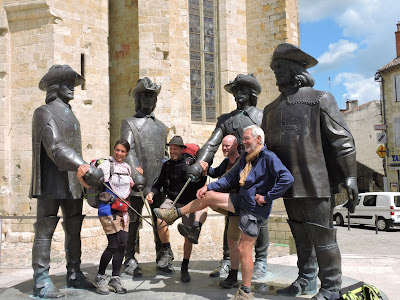 |
Chateau Cadillac in 1759
|
Cadillac
is a village of only 2500 inhabitants, but it also had its fortified wall built
during the 100 Years War between France and England. We entered by the Porte du
Mere (Sea Gate) built in 1315. Here they showed how the floods can affect the
town - the worst flood actually reached the top of the gate. This was one of
the original four gates. The town is a Bastide - fortified towns created by
charter, built in the 13
th and 14
th centuries. Here people built their houses and then farmed the
surrounding land. Inside the walls, the 16th century chateau of
Jean-Louis deLa Valette, first duke of Epernon. Henry III had given him many titles and
posts, but Henri IV tried to sideline him by having him build an expensive
chateau worthy of his rank, far from the capital. It had a traditional U shaped
design. It was designed by two different architects so the front and the back
are different. In 1818, the state acquired the chateau and it became a women's
prison until 1890 and then a reform school for girls until 1952. While it was a
prison, it was run by nuns and they enforced silence throughout the day. The
prisoners would rise at 5 AM, have time for prayer followed by breakfast and
then work in the workshops. Before lunch they could walk in single file around
the courtyard. The same pattern was repeated in the afternoon and after dinner.
The kitchen was interesting because it contained one of the first dumbwaiters
for serving the food as well as a connection to a sewer which ran to the river.
The kitchen also served as a workshop for making the tapestries of Cadillac.
Only one such tapestry remains in the chateau, the Siege of La Rochelle. So is there a relation between Cadillac, France and the Cadillac car? Yes, both were named for
Antoine Laumet de La Mothe, sieur de Cadillac, the founder of Detroit.
 |
The Seige of La Rochelle
|
In the
afternoon, we visited a family run winery,
Chateau Piada, in the region
Barsac-Sauterne. The chateau was originally from 1274. The current owner's
grandfather bought the winery in 1940 from a cousin. Frederick, the owner, is
trying to learn English to better host the Grand Circle visitors. He did pretty
well for the several months of practice, but his vocabulary, as you might imagine,
is somewhat limited.
We also
met his Father, Jean, whose story of World War II we heard. In the early years,
the Belgian and French forces were fleeing from the enemy. They would live for
over ten years without electricity or gasoline, but continue to farm. One
morning, they listened for 15 hours to the deafening engine noise of the German
army passing by. Eventually some young SS troops were stationed here. Jean as a
10 year old boy was impressed by their discipline, goose-stepping parade, and
singing. In 1944, a room in their house was commandeered for two lieutenants
who had been on the Russian front and they heard the stories of the atrocities
that were committed between the Germans and Russians. Later, they would have a
similar experience in France.
 |
Jean
|
We tasted
three white wines that were very fruity and unique. The fog from the river here
encourages a fungus to grow on the grapes , the
Botyrtis Cinerea. The grapes
are harvested in 4-6 picking choosing the grapes that have been shriveled up
the fungus. The wine is aged for one year in barrels and then filtered and kept
in stainless steel vats until 18-20 months after the harvest. They only produce
about 1100 bottles a year from this winery.
After our
visit, we almost got lost trying to find the
Chateau Yquem, one of the top
wineries in the region. The gardens of this Chateau were truly magnificent and
the Chateau was quite picturesque. On the way back to the ship, our bus broke
down, and Frederick and Jean ended up ferrying us in two cars to get back. More
of an adventure then we had planned on.
 |
The gardens of Chateau Yquem
|
The
directors invited Frederick and Jean to the Captain's farewell dinner. The
meals on this ship have been exceptional. We had some terrific soups, eggplant
and mustard soup, which were quite unique and delicious. Tonight’s meal was
filet-mignon, one of the best I've ever tasted. Afterwards we had the crew
talent show. Of course, there was much more show than talent and had everyone
laughing. It didn't hurt that we had a margarita and several glasses of wine
beforehand. By the end of the evening we were up dancing the chicken dance and
YMCA.





















































